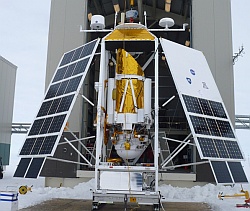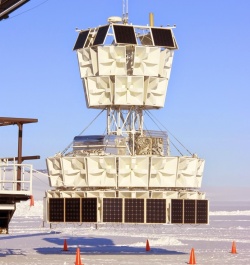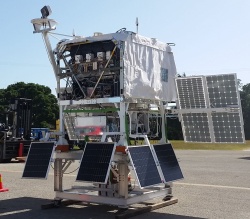News Archive 2016
-
November, 4th 2016
Balloon launch campaign starting in Antarctica
McMurdo Station, Antarctica.- When November arrives, the permanent residents of the McMurdo station are prepared for the flooding that comes from Christchurch, New Zealand. Airplane after airplane, scientists of every branch of science, and from every corner of the world, come to the white continent to make their research.
And every year, since 1990, a very special kind of them arrive. They were baptized with a sense of humor as the "balloonatics", the people that launch balloons.
This year, along with the staff from the Columbia Scientific Balloon Facility, in charge of the launch operations at the Long Duration Balloon Facility, located in Williams Field airport outside McMurdo station, a total of four teams will be on the ice with their instruments looking for a chance to send them to the stratosphere.
Let's meet them.
STO
The first one we will review is the Stratospheric Terahertz Observatory or STO a NASA funded project developed by the University of Arizona and the Johns Hopkins Applied Physics Laboratory, along with a collaboration which includes the Arizona State University, the Oberlin College, the Smithsonian Astrophysical Observatory, the SETI Institute, the Jet Propulsion Laboratory, and the California Institute of Technology from United States, along with the University of Cologne from Germany.
STO goal is to study the lifecycle of the Interstellar Medium, during long duration flights in a stratospheric balloon. The project will survey large dense molecular clouds in the southern sky of the Milky Way to analyze ionized carbon and nitrogen fine structure lines.
Update: STO-2 was succesfuly launched on 12/8/2016 see my chronicle
This will be the third mission of the telescope after a first short duration engineering flight over New Mexico in 2009, and a first long duration flight over Antarctica in 2012. The mission was originally planned to be carried out during last year's Antarctic campaign but non cooperative weather forced to close the campaign before a suitable launch window could be find for STO. The instrument remained in storage at McMurdo during the entire year, so the team would assess first how much impact had on it the antarctic climate.
ANITA
The second instrument we will review is ANITA, which stands for Antarctic Impulse Transient Antenna, and as can we see in the image below, is one of the weirdest-looking instruments ever flown in a stratospheric balloon.
The main goal of ANITA is to detect extremely rare particles of ultra high energy and cosmic origin called neutrinos. ANITA detects the radio pulses emitted by their interactions with the Antarctic ice sheet 35 km below, thanks to the Askaryan effect. The "ears" of ANITA are composed by an array of 32 radio antennas, cylindrically arranged with an approximate radius of 3 meters and a height of 5 meters.
This will be the fourth antarctic tour of the instrument after the missions carried out in 2006, 2008 and 2014. ANITA is the result of a collaboration by the University of Hawaii, the Jet Propulsion Laboratory (JPL), the Ohio State University, the Stanford Linear Accelerator Center, the University of California, the University of Delaware, the University of Minnesota and Washington University, St. Louis.
Update: ANITA IV was succesfully launched on 12/2/2016 see my chronicle
Once launched, the balloon carrying ANITA will be joined a few days later by another balloon, but of a small size, which will trail after it following more or less the same path. This second balloon will be carrying a small instrument called ANITA HiCal which will study the surface roughness of the ice emitting kiloVolt scale signals that will be measured by both ANITA directly and in the surface reflection. This particular instrument -which was first flown with ANITA III mission in 2014- was developed by a team of the University of Kansas.
BACCUS
The Third instrument to be launched during this season -BACCUS- seems to be related to Roman Mythology, but far from that, the acronym stands for Boron And Carbon Cosmic rays in the Upper Stratosphere.
It is an instrument developed by another extensive collaboration lead by the University of Maryland and including the Pensylvania State University, the Ohio State University and NASA Goddard Space Flight Center from USA, Ewha Woman's University, KAIST and KyungPook National University from Korea, the Laboratoire de Physique Subatomique et de Cosmologie, Grenoble and Centre d'Etude Spatiale des Rayonnements of France and the Universidad Nacional Autónoma de México.
The core of BACCUS is based on the Cosmic Ray Energetics and Mass (CREAM) an instrument developed by the same group which performed six long duration balloon missions in Antarctica, obtaining a total ammount of 161 days of data on cosmic rays. A subset of detectors from CREAM have been upgraded and reassembled for this new payload.
From this flight on, BACCUS will follow the research originally performed by CREAM: to directly measure the elemental spectra from lithium to iron nuclei with energies up to 1015 eV. The former CREAM instrument -with several modifications- is awaiting his turn to be launched to the International Space Station onboard SpaceX-12 mission in 2017.
Update: BACCUS was succesfuly launched on 11/28/2016, see my chronicle
On its maiden flight BACCUS will transport another payload denominated Cosmic Radiation Exposure Seed System or CRESS developed by a team of the University of Florida which will expose wild-type Arabidopsis thaliana seeds to the cosmic radiation in the stratosphere. This project is an initial technology development for constructing reusable biological exposure platform for use on stratospheric balloons. CRESS was launched recently in a NASA balloon from New Mexico as part of the HASP student program, now it will benefit of the longer exposure times onboard the balloon that will transport BACCUS around the pole.
Stay tuned, to more news as the campaign unfolds.
-
Share this on social media





